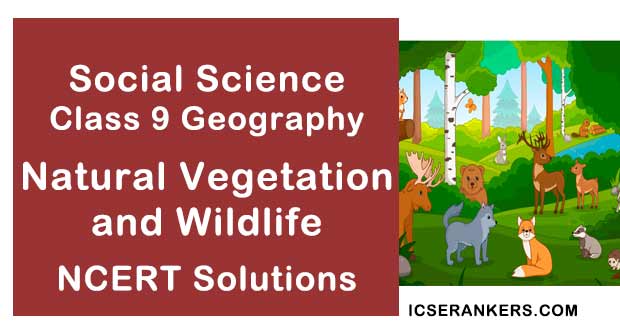NCERT Solutions Class 10 Social Science Geography Chapter 5 Natural Vegetation and Wild Life

Chapter 5 Natural Vegetation and Wild Life Questions and Answer
Chapter Name | Natural Vegetation and Wild Life NCERT Solutions |
Class | CBSE Class 10 |
Textbook Name | Contemporary India Class 10 |
Related Readings |
|
(i) To which one of the following types of vegetation does rubber belong to?
(a) Tundra
(b) Himalayan
(c) Tidal
(d) Tropical Evergreen
Answer
(d) Tropical Evergreen
(ii) Cinchona trees are found in the areas of rainfall more than
(a) 100 cm
(b) 70 cm
(c) 50 cm
(d) less than 50 cm
Answer
(a) 100 cm
(iii) In which of the following state is the Simlipal bio-reserve located?
(a) Punjab
(b) Delhi
(c) Odisha
(d) West Bengal
Answer
(d) West Bengal
(iv) Which one of the following bio-reserves of India is not included in the world network of bioreserve?
(a) Manas
(b) Gulf of Mannar
(c) Nilgiri
(d) Nanda devi
Answer
(a) Manas
2. Answer the following questions briefly.
(i) Define an ecosystem.
(ii) What factors are responsible for the distribution of plants and animals in India?
(iii) What is a bio-reserve? Give two examples.
(iv) Name two animals having habitat in tropical and montane type of vegetation.
Answer
(i) All the plants and animals in an area are interdependent on each other. The plants and animals; along with their physical environment make the ecosystem.
(ii) Relief (Land and soil) and Climate (Temperature, humidity, photoperiod and precipitation) are the factors which are responsible for the distribution of plants and animals in India.
(iii) A biosphere reserve is an area proposed by its residents, ratified by a national committee, and designated by UNESCO’s Man and Biosphere (MAB) program, which demonstrates innovative approaches to living and working in harmony with nature.
(iv) Tropical (Elephant, deer) and Montane (yak, snow leopard)
3. Distinguish between
(i) Flora and Fauna
(ii) Tropical Evergreen and Deciduous forests
Answer
(i) Plant species comprise the flora, while animal species comprise the fauna.
(ii) Trees of evergreen forests do not shed their leaves at a fixed time in a year, while trees of deciduous forest shed their leaves at a fixed time in a year.
4. Name different types of Vegetation found in India and describe the vegetation of high altitudes.
Answer
There are five major types of vegetation in India: Tropical Rainforests, Tropical Deciduous Forests, Tropical Thorn Forests and Scrubs, Montane Forests and Mangrove Forests.
Montane Forest: The forests in the mountainous areas are called montane forest. These forests are mainly found along the southern slopes of the Himalayas and at high altitudes in southern and north eastern India. Kashmir stag, spotted deer, wild sheep, jack rabbit, Tibetan antelope, yak, snow leopard, squirrels, Shaggy horn wild ibex, bear, rare red panda, sheep and goats are the common animals in these forests.
5. Quite a few species of plants and animals are endangered in India. Why?
Answer
Large scale deforestation has reduced the natural habitat of many plants and animals. Due to this, many species of plants and animals are endangered in India.
6. Why has India a rich heritage of flora and fauna?
Answer
India has a variety of climatic conditions; like tropical, subtropical, desert and mountainous. Due to this, there are enough habitats for a large variety of flora and fauna. Due to this, India has a rich heritage of flora and fauna.
